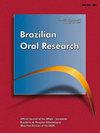Effect of thickness and shade of CAD/CAM composite on the light transmission from different light-curing units
IF 2.5
4区 医学
Q2 Dentistry
引用次数: 0
Abstract
The thickness and shade of a restoration will affect the transmission of light from the light-curing unit (LCU). This study determined the power (mW), spectral radiant power (mW/nm), and beam profile of different LCUs through various thicknesses and shades of a CAD-CAM resin composite (BRAVA Block, FGM). Five thicknesses: 0.5; 0.75; 1.0; 1.5, and 2.0 mm, in three shades: Bleach; A2 and A3.5 of a CAD-CAM resin (n = 5). Two single-peak LCUs: EL, Elipar DeepCure-S (3M Oral Care); and OP, Optilight Max (Gnatus), and one multiple-peak LCU: VL, VALO Grand (Ultradent), were used. The LCUs were positioned touching the surface of the BRAVA Block. The power and emission spectrum were measured using a fiberoptic spectrometer attached to an integrating sphere, and the beam profiles using a laser beam profiler. The effect of the material thickness on the light attenuation coefficients was determined. VL and EL delivered more homogeneous beam profiles than OP. The type of the BRAVA Block had a significant effect on the transmitted power, and wavelengths of transmitted light (p < 0.001). There was an exponential reduction in the power and emission spectrum as the thickness of the BRAVA Block increased (p < 0.001). The light transmission through the A2 shade was least affected by the thickness (p < 0.001). The attenuation coefficient was higher for the violet light and higher for A3.5 than the A2 or Bleach shades. No violet light from the VL could be detected at the bottom of 2.0 mm of the BRAVA Block.CAD/CAM复合材料厚度和色度对不同光固化单元透光性的影响
修复物的厚度和阴影会影响光固化单元(LCU)的光透射。本研究通过不同厚度和颜色的CAD-CAM树脂复合材料(BRAVA Block, FGM)测定了不同lcu的功率(mW)、光谱辐射功率(mW/nm)和光束轮廓。五种厚度:0.5;0.75;1.0;1.5和2.0毫米,有三种颜色:漂白;A2和A3.5的CAD-CAM树脂(n = 5)。两个单峰lcu: EL, Elipar DeepCure-S (3M Oral Care);和OP, Optilight Max (Gnatus),以及一个多峰LCU: VL, VALO Grand (Ultradent)。lcu放置于BRAVA块的表面。功率和发射光谱的测量采用了连接在积分球上的光纤光谱仪,光束轮廓采用了激光光束轮廓仪。确定了材料厚度对光衰减系数的影响。与op相比,VL和EL的光束轮廓更均匀。BRAVA块的类型对透射功率和透射光波长有显著影响(p < 0.001)。随着BRAVA块厚度的增加,功率和发射光谱呈指数降低(p < 0.001)。A2遮光片厚度对透光率的影响最小(p < 0.001)。紫光和A3.5光的衰减系数高于A2或漂白光。BRAVA块底部2.0 mm处未检测到VL紫光。
本文章由计算机程序翻译,如有差异,请以英文原文为准。
求助全文
约1分钟内获得全文
求助全文
来源期刊

Brazilian Oral Research
DENTISTRY, ORAL SURGERY & MEDICINE-
CiteScore
3.70
自引率
4.00%
发文量
107
审稿时长
12 weeks
 求助内容:
求助内容: 应助结果提醒方式:
应助结果提醒方式:


